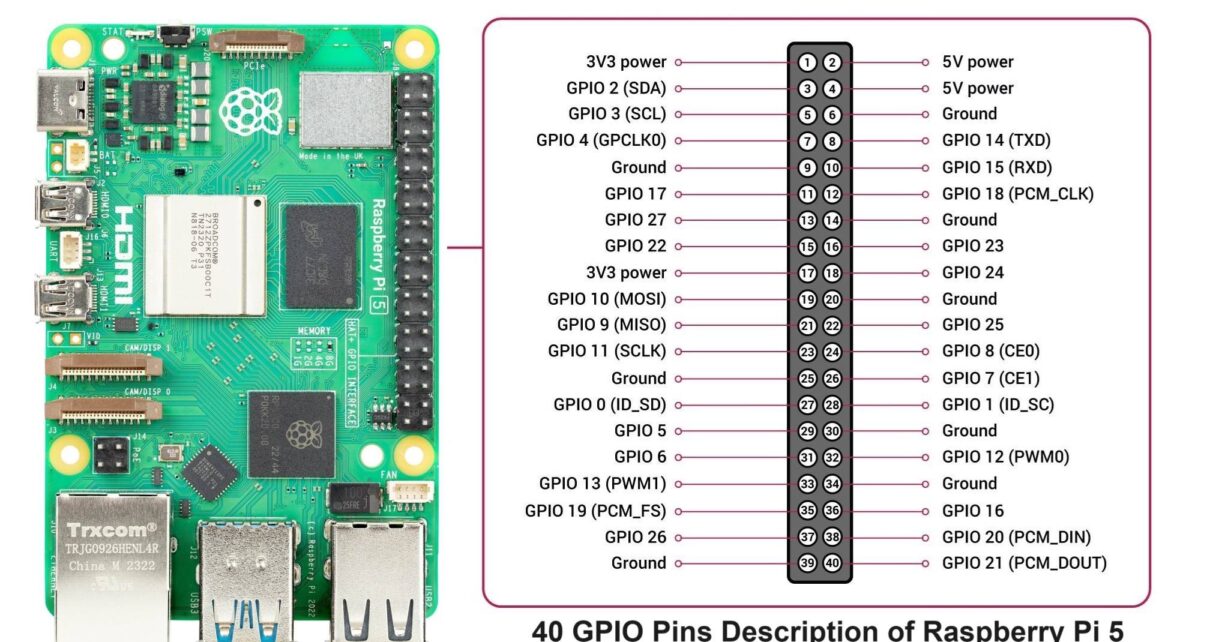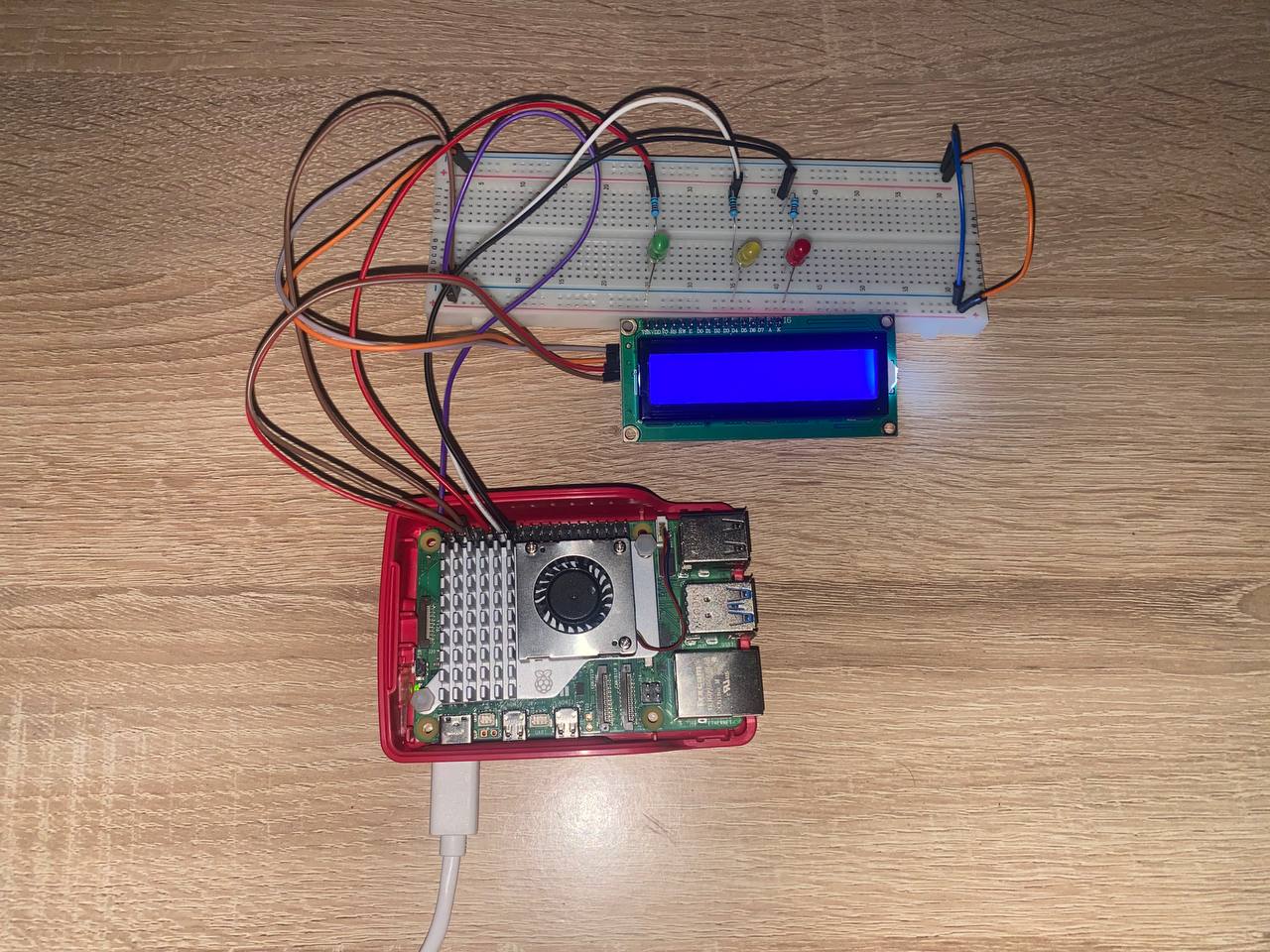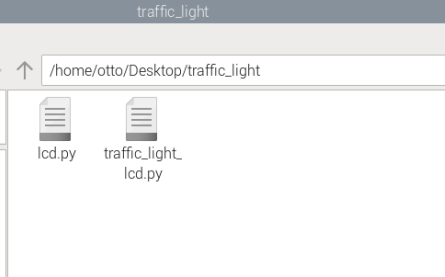Raspberry Pi Traffic Light with LCD Display – Beginner Project
Introduction
This tutorial will guide you through building a fully functioning traffic light system using a Raspberry Pi. It features Red, Yellow, and Green LEDs, all synchronized with an I2C LCD display that shows the current phase and a live countdown.
Perfect for beginners who want to learn GPIO pin control, timing, and I2C LCD communication using Python.
What You’ll Need
| Component | Quantity |
|---|---|
| Raspberry Pi (4 or 5) | 1 |
| Red, Yellow, Green LEDs | 1 each |
| 330Ω Resistors | 3 |
| Breadboard | 1 |
| Jumper Wires | Several |
| I2C 16x2 LCD Display | 1 |
| I2C LCD Backpack (usually built-in) | ✅ |
Wiring the Circuit
| LED | GPIO Pin | Physical Pin |
|---|---|---|
| Red | GPIO 17 | Pin 11 |
| Yellow | GPIO 27 | Pin 13 |
| Green | GPIO 22 | Pin 15 |
| GND | — | Pin 6 |
| LCD SDA | — | Pin 3 (GPIO 2) |
| LCD SCL | — | Pin 5 (GPIO 3) |


Use a 330Ω resistor on each LED’s long leg (anode). Connect the short leg to ground.
To check your LCD’s I2C address:
sudo apt install -y i2c-tools
i2cdetect -y 1Usually, the address is 0x27 or 0x3F.
Python Code
Save this as traffic_light_lcd.py:
import RPi.GPIO as GPIO
import time
from smbus2 import SMBus
from lcd import LCD # Make sure lcd.py is in the same directory
# GPIO Pins
RED = 17
YELLOW = 27
GREEN = 22
# Setup GPIO
GPIO.setmode(GPIO.BCM)
GPIO.setup([RED, YELLOW, GREEN], GPIO.OUT)
# Setup LCD
bus = SMBus(1)
lcd = LCD(bus)
def display_phase(led_pin, label, duration):
"""Turn on LED, update LCD, countdown, and turn off"""
GPIO.output(led_pin, True)
for i in range(duration, 0, -1):
lcd.display(label, f"Time: {i}s")
time.sleep(1)
GPIO.output(led_pin, False)
def traffic_light_cycle():
while True:
display_phase(GREEN, "GO", 5)
display_phase(YELLOW, "WAIT", 2)
display_phase(RED, "STOP", 5)
try:
traffic_light_cycle()
except KeyboardInterrupt:
print("Exiting...")
finally:
lcd.clear()
GPIO.cleanup()
lcd.py Driver File
Create a file called lcd.py in the same directory:
import smbus2
import time
class LCD:
def __init__(self, bus, addr=0x27):
self.bus = bus
self.addr = addr
self.backlight = 0x08
self.EN = 0b00000100
self.RS = 0b00000001
self.init_display()
def write_byte(self, data):
self.bus.write_byte(self.addr, data | self.backlight)
time.sleep(0.0005)
def toggle_enable(self, data):
self.write_byte(data | self.EN)
time.sleep(0.0005)
self.write_byte(data & ~self.EN)
time.sleep(0.0001)
def write_command(self, cmd):
self.write_4bits(cmd & 0xF0)
self.write_4bits((cmd << 4) & 0xF0)
def write_char(self, charvalue):
self.write_4bits(charvalue & 0xF0, True)
self.write_4bits((charvalue << 4) & 0xF0, True)
def write_4bits(self, data, char_mode=False):
bits = data | self.backlight
if char_mode:
bits |= self.RS
self.write_byte(bits)
self.toggle_enable(bits)
def init_display(self):
self.write_4bits(0x30)
time.sleep(0.005)
self.write_4bits(0x30)
time.sleep(0.001)
self.write_4bits(0x30)
time.sleep(0.001)
self.write_4bits(0x20)
self.write_command(0x28)
self.write_command(0x08)
self.write_command(0x01)
time.sleep(0.002)
self.write_command(0x06)
self.write_command(0x0C)
def clear(self):
self.write_command(0x01)
time.sleep(0.002)
def set_cursor(self, line, position):
pos = position + (0x80 if line == 0 else 0xC0)
self.write_command(pos)
def display(self, line1="", line2=""):
self.clear()
self.set_cursor(0, 0)
for char in line1.ljust(16)[:16]:
self.write_char(ord(char))
self.set_cursor(1, 0)
for char in line2.ljust(16)[:16]:
self.write_char(ord(char))

What You Learn
- Using GPIO to control hardware
- Controlling a 16x2 LCD via I2C
- Python scripting with loops and timers
- Synchronizing display output with physical actions
Conclusion
This traffic light system is a great starter project to practice real-time control and feedback using Raspberry Pi. You now have a fully synchronized LED + LCD system using Python.
Want to take this further with sensors or automation? Drop a comment or question below — let’s build together!
Comments (0)
No comments yet. Be the first to comment!
Leave a Comment